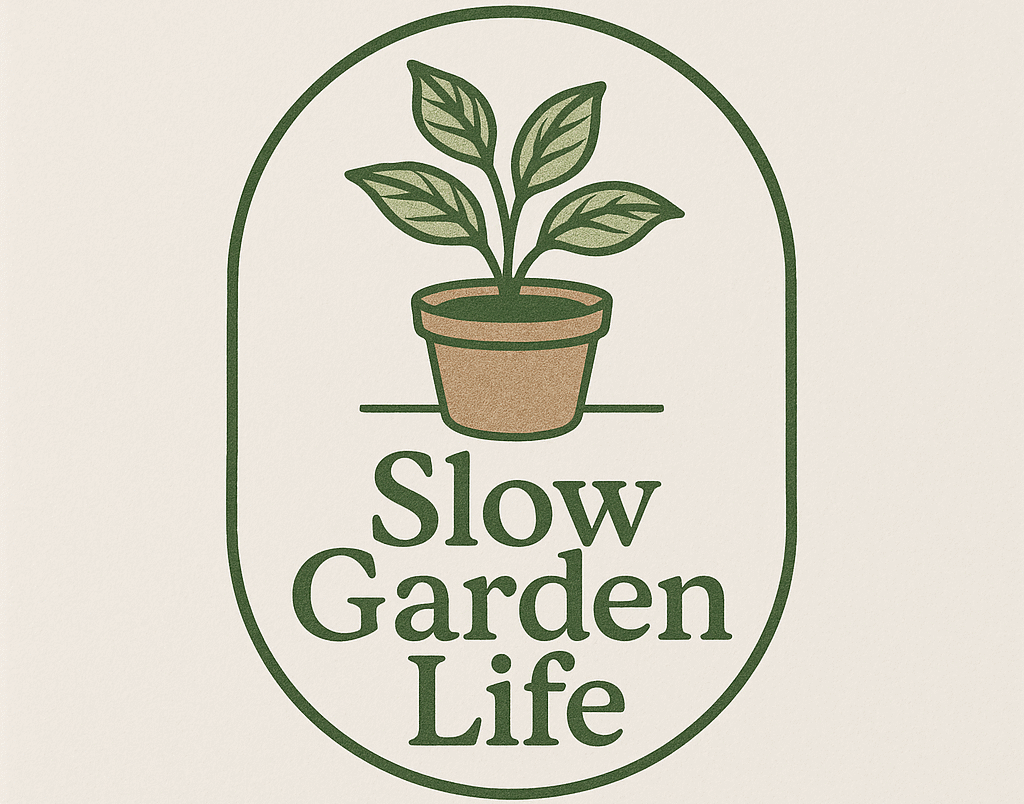There’s nothing quite like the satisfaction of plucking fresh lemons from your own backyard tree. Growing a lemon tree isn’t just about adding beauty to your garden – it’s about creating a sustainable source of vitamin-rich fruit that’ll enhance your cooking and save you money at the grocery store.
Whether you’re dreaming of homemade lemonade or fresh citrus for your favorite recipes, we’re here to guide you through every step of the process. From selecting the perfect variety to mastering proper care techniques, growing your own lemon tree is more achievable than you might think.
With the right knowledge and a little patience, you’ll discover that cultivating healthy lemon trees can become one of your most rewarding gardening adventures. Let’s explore how to transform that small sapling into a thriving citrus powerhouse that’ll provide fresh lemons for years to come.
Choose the Right Lemon Tree Variety for Your Climate
Selecting the perfect lemon variety sets the foundation for your tree’s long-term success and fruit production. We’ll explore three popular varieties that thrive in different climate conditions and growing situations.
Meyer Lemon Trees for Beginners
Meyer lemon trees offer the ideal starting point for new citrus growers. These compact trees typically reach 6-10 feet in height and produce sweeter, less acidic fruit than traditional lemons. We recommend Meyer varieties because they’re naturally dwarf trees that adapt well to container growing.
Cold tolerance makes Meyer lemons perfect for zones 9-11, though they can survive brief periods down to 20°F. Their thin, smooth skin and orange-yellow color distinguish them from other lemon varieties. Meyer trees begin producing fruit within 2-3 years when grown from grafted stock.
Container growing allows us to move Meyer lemon trees indoors during winter months in colder climates. These trees require 6-8 hours of direct sunlight daily and prefer well-draining soil with a pH between 5.5-6.5.
Eureka Lemons for Year-Round Production
Eureka lemon trees deliver consistent fruit production throughout the year in suitable climates. These vigorous trees can reach 15-20 feet tall and produce the classic yellow lemons we see in grocery stores. We appreciate Eureka varieties for their ability to bloom and fruit simultaneously.
Peak harvest seasons occur in winter and spring, though Eureka trees produce lemons year-round in zones 9-10. Their thick, textured skin and highly acidic juice make them excellent for cooking and cleaning purposes. Eureka trees typically begin fruiting 3-4 years after planting.
Commercial growers favor Eureka lemons because they store well and transport easily. These trees prefer coastal Mediterranean climates with mild winters and aren’t as cold-hardy as other varieties, experiencing damage at temperatures below 28°F.
Lisbon Lemons for Cold Tolerance
Lisbon lemon trees provide the best cold resistance among common lemon varieties. These hardy trees can withstand temperatures as low as 24°F and thrive in zones 8-10. We recommend Lisbon varieties for gardeners in slightly cooler regions who still want fresh lemons.
Growth habits include thorny branches and dense foliage that can reach 15-25 feet without pruning. Lisbon lemons produce fruit primarily in winter and spring, with peak harvest occurring from February through May. Their juice content exceeds most other lemon varieties, making them perfect for fresh lemonade.
Wind tolerance gives Lisbon trees an advantage in coastal areas with strong ocean breezes. These trees develop deep root systems that anchor them securely while accessing water during dry periods. Lisbon lemons feature thick, bumpy skin that protects the fruit during transport and storage.
Select the Perfect Location for Your Lemon Tree
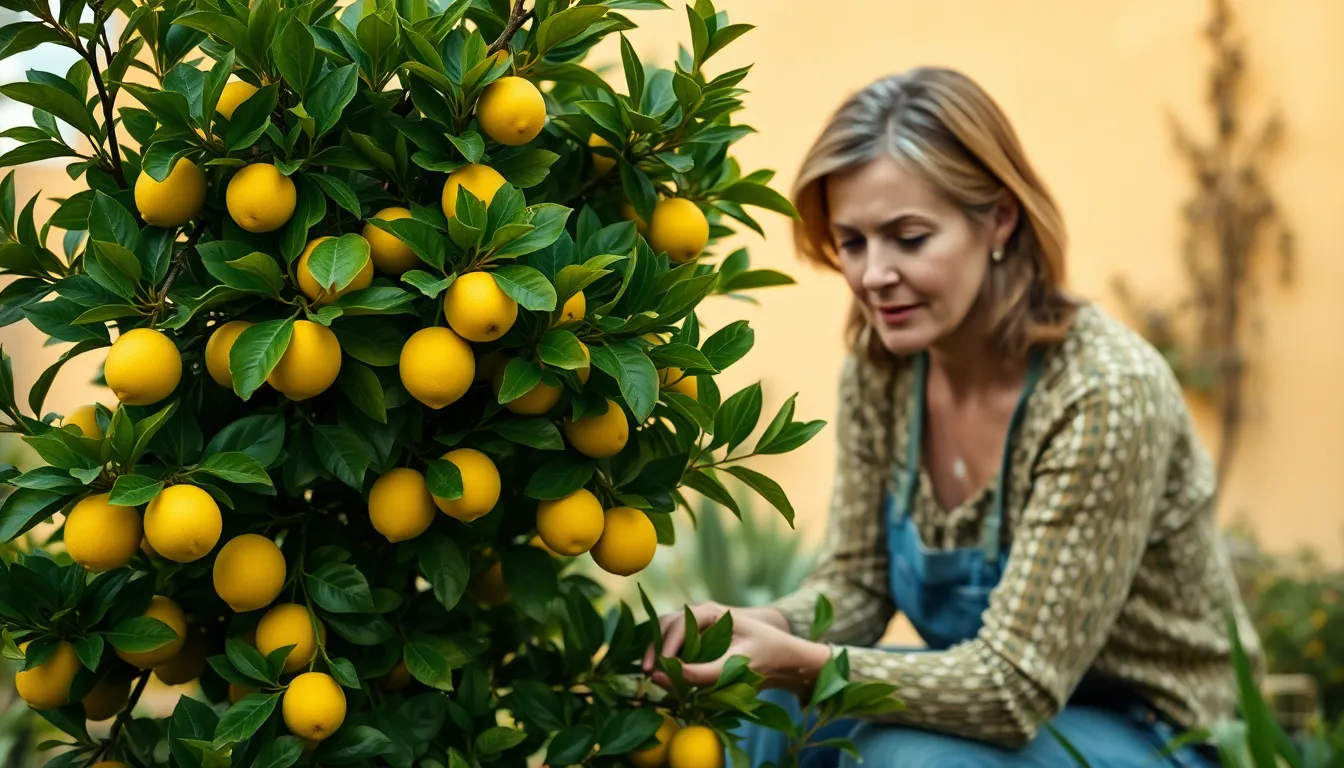
Finding the ideal spot for your lemon tree sets the foundation for years of successful fruit production. We’ll explore the essential factors that determine whether your tree thrives or merely survives.
Sunlight Requirements and Positioning
Direct sunlight exposure makes the difference between a struggling tree and a productive one. Your lemon tree needs 6 to 8 hours of direct sunlight daily to develop healthy foliage and abundant fruit. South-facing locations provide the most consistent light throughout the day, giving your tree the energy it needs for optimal growth.
Position matters significantly when maximizing sun exposure. We recommend measuring sunlight patterns in your chosen spot across different seasons. Areas that receive morning sun help dry dew quickly, reducing fungal issues. Afternoon sun provides the intense light needed for fruit development and sugar concentration.
Indoor positioning requires strategic planning for adequate light. Place container-grown trees near south-facing windows where they’ll receive the strongest natural light. Grow lights become essential supplements when natural sunlight falls short of the required 6 to 8 hours, especially during winter months.
Protection From Wind and Frost
Wind damage poses one of the greatest threats to lemon tree health. Strong winds can break branches, strip leaves, and stress the entire plant. We suggest planting your tree near structures like walls or fences that provide natural windbreaks without blocking sunlight.
Frost protection requires proactive planning in cooler climates. Lemon trees suffer damage when temperatures drop below 29°F for extended periods. Create barriers using frost cloth, blankets, or even Christmas lights wrapped around branches to provide gentle warmth during cold snaps.
Strategic placement near heat-retaining surfaces offers additional protection. South-facing walls absorb heat during the day and release it slowly at night, creating a warmer microclimate. Concrete patios and stone pathways provide similar benefits by moderating temperature fluctuations around your tree.
Indoor vs Outdoor Growing Considerations
Outdoor growing delivers the best results in suitable climates. Trees planted directly in well-draining soil develop stronger root systems and typically produce more fruit than their container-bound counterparts. Spring planting allows roots to establish before facing summer heat or winter cold.
Indoor cultivation opens possibilities for gardeners in challenging climates. Container growing lets you move trees to protected locations during extreme weather while maintaining control over soil conditions and drainage. Choose containers at least 20 gallons in size to accommodate mature root development.
Climate considerations determine your growing approach. We recommend outdoor planting in USDA zones 9-11 where temperatures rarely drop below freezing. Colder regions benefit from container growing with seasonal movement between indoor and outdoor locations.
Prepare the Ideal Soil Conditions
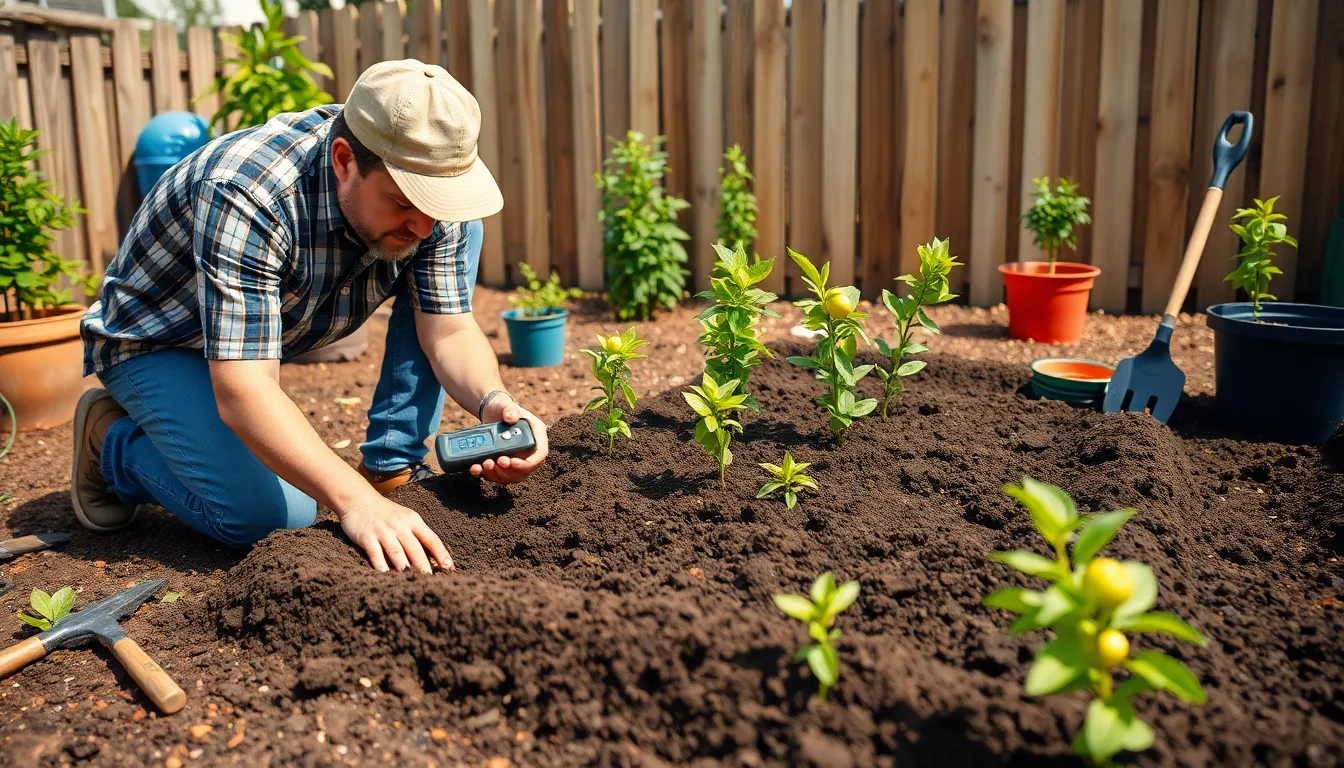
Creating the perfect foundation for your lemon tree starts with understanding what makes soil truly suitable for citrus growth. We’ll guide you through the essential elements that transform ordinary dirt into a thriving environment for your tree.
Soil pH and Drainage Requirements
Testing your soil’s pH level ensures optimal nutrient absorption for lemon trees. Our target range falls between 6.0 to 7.0, which provides the slightly acidic to neutral conditions these citrus plants crave. Digital pH meters or simple test strips from garden centers give accurate readings within minutes.
Drainage becomes critical since waterlogged roots spell disaster for lemon trees. Standing water creates anaerobic conditions that promote root rot and fungal diseases. Clay soils particularly struggle with drainage issues, requiring amendments like perlite, coarse sand, or organic compost to improve water flow.
Quick drainage tests reveal whether your soil needs improvement. Dig a hole 12 inches deep and fill it with water. Properly draining soil empties completely within 24 hours, while slower drainage indicates the need for amendments.
Nutrient-Rich Soil Amendments
Organic matter transforms poor soil into a nutrient-rich growing medium. Compost adds essential minerals while improving soil structure and water retention. Well-rotted manure provides slow-release nitrogen that feeds your lemon tree throughout the growing season.
Regular fertilization during spring and summer supports vigorous growth and fruit production. Balanced fertilizers with equal parts nitrogen, phosphorus, and potassium work best for young trees. Established trees benefit from citrus-exact fertilizers that include micronutrients like iron and zinc.
Mulching around the base conserves moisture and adds nutrients as it decomposes. Wood chips, shredded bark, or compost create a 3-inch layer that suppresses weeds while slowly enriching the soil beneath.
Container vs Ground Planting Options
Container planting offers flexibility for gardeners with limited space or challenging climates. Pots measuring at least 14 inches deep and wide provide adequate root space for dwarf varieties. Multiple drainage holes prevent water accumulation that damages root systems.
Ground planting allows unrestricted root development and larger tree size. South-facing locations with 6 to 8 hours of direct sunlight create ideal conditions for maximum fruit production. Dig holes twice as wide as the root ball but only as deep to prevent settling issues.
Soil preparation differs between planting methods but follows similar principles. Container plants need commercial potting mix blended with compost, while ground plantings benefit from native soil improved with organic amendments. Both options require consistent moisture without waterlogging to support healthy lemon tree growth.
Plant Your Lemon Tree Properly
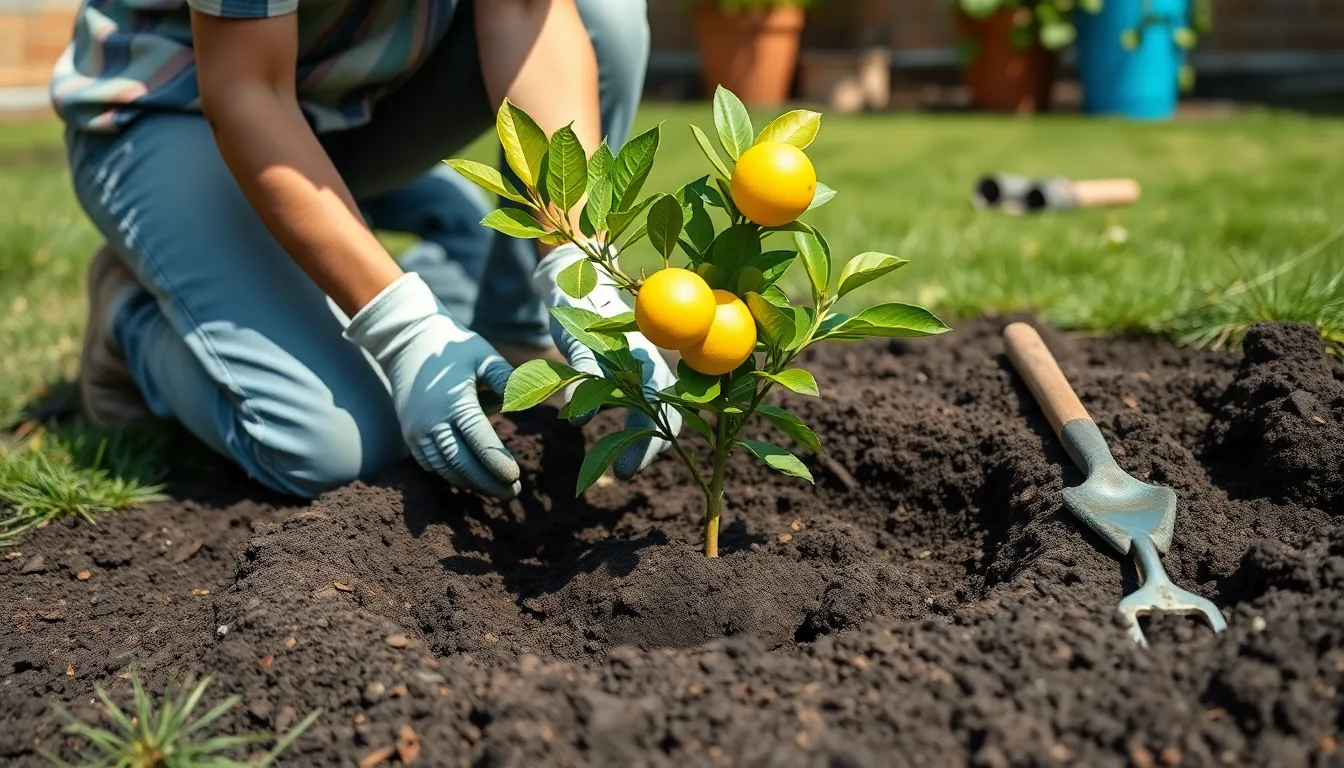
Now that we’ve prepared our soil and chosen the perfect location, it’s time to plant our lemon tree with the right techniques for long term success.
Best Planting Season and Timing
Spring planting gives our lemon trees the best chance to establish strong root systems before facing seasonal challenges. We should plant in early spring after the risk of frost has completely passed to ensure optimal growth conditions.
Avoiding extreme seasons protects our young trees from unnecessary stress during their most vulnerable establishment period. Harsh winter conditions can damage tender roots while intense summer heat makes it difficult for newly planted trees to retain adequate moisture.
Temperature considerations play a crucial role in timing our planting efforts for maximum success. We want soil temperatures to remain consistently warm without the scorching heat that summer months often bring to many growing regions.
Proper Hole Depth and Spacing
Hole dimensions should be twice as wide and as deep as our tree’s root ball to provide adequate space for root expansion. This generous sizing allows roots to spread naturally into the surrounding soil without becoming cramped or circling.
Mature size planning requires us to consider that lemon trees reach 10 to 20 feet tall and 10 to 15 feet wide at full maturity. We need to allow ample space around each tree to prevent overcrowding and ensure proper air circulation.
Distance calculations should account for both the tree’s canopy spread and our access needs for maintenance and harvesting. Proper spacing prevents competition between trees while making routine care tasks much more manageable.
Root Ball Preparation Techniques
Root loosening becomes essential when we encounter bound or circled roots that could restrict future growth. We should carefully cut across tightly bound root balls to encourage healthy root spread into the surrounding well drained soil.
Soil enhancement involves mixing organic matter or compost directly into our planting area to improve both drainage and fertility. This preparation creates the ideal growing environment that supports strong root development from the moment we plant.
Organic amendments like compost and well rotted manure provide essential nutrients while improving soil structure for better water management. These natural additions create the foundation our lemon trees need to establish quickly and grow vigorously in their new location.
Establish a Consistent Watering Schedule
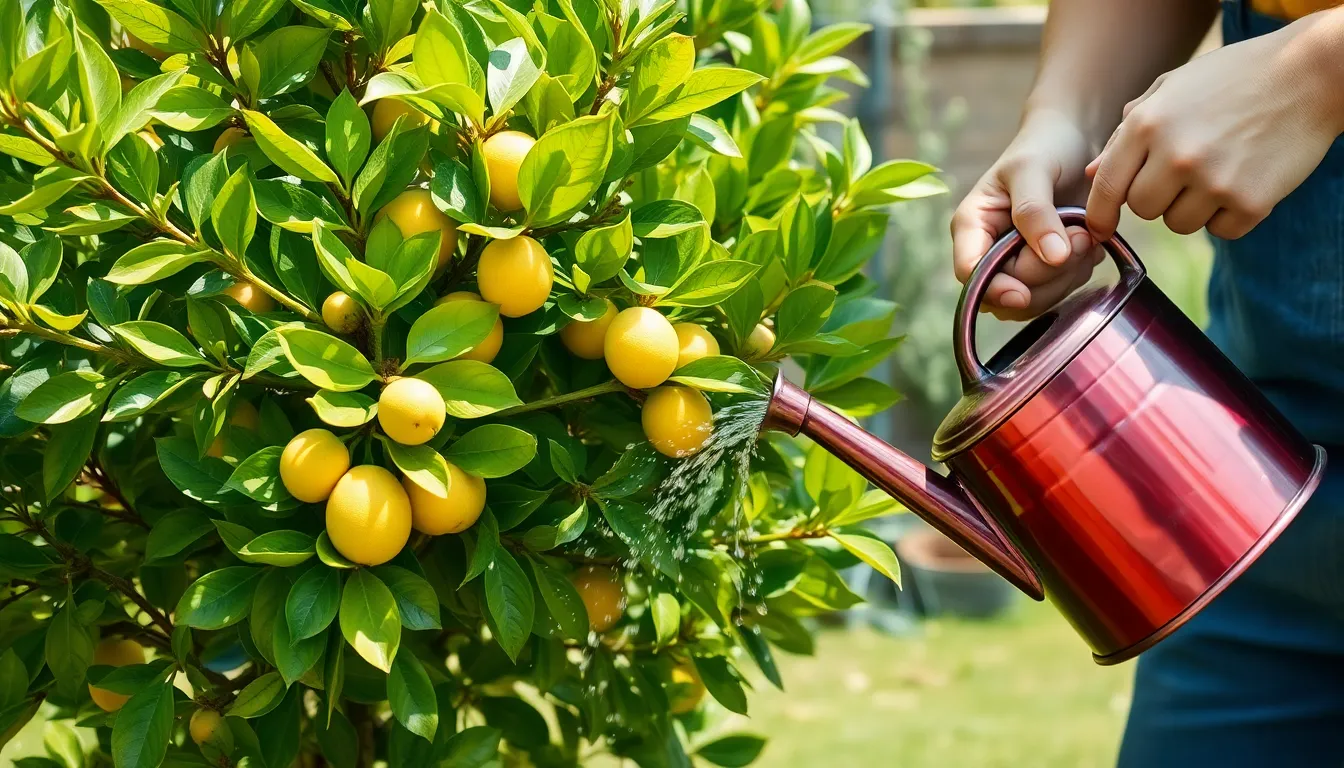
Now that we’ve planted our lemon tree in ideal soil conditions, maintaining proper hydration becomes our next critical step. Regular watering keeps the soil consistently moist while preventing the waterlogged conditions that can harm our tree’s root system.
Deep Watering vs Frequent Light Watering
Deep watering encourages our lemon tree’s roots to grow deeper into the soil, promoting drought tolerance and stable growth. We should water slowly and thoroughly, allowing moisture to penetrate at least 6 to 8 inches deep. This method requires less frequent watering sessions but delivers ample water each time.
Frequent light watering creates shallow root systems and increases our risk of root rot. Surface soil stays wet longer with this approach, creating conditions that harm our tree’s health. We avoid daily light watering in favor of deeper soakings spaced appropriately based on how quickly our soil dries.
Thorough watering after planting helps settle the roots and provides essential initial moisture. For container-grown lemon trees, we maintain moist soil conditions without letting the potting mix become soggy.
Seasonal Water Adjustment Guidelines
Spring and summer demand increased watering frequency and quantity as our lemon tree actively grows. Warmer temperatures and drier weather conditions accelerate moisture loss during these growing seasons.
Fall and winter require reduced watering as growth slows and cooler temperatures lower evaporation rates. Overwatering during cold months can seriously harm our tree’s health and development.
| Season | Watering Frequency | Key Considerations |
|---|---|---|
| Spring/Summer | Increased frequency | Active growth period, warmer weather |
| Fall/Winter | Reduced frequency | Slower growth, lower evaporation |
Weather conditions and soil moisture levels guide our watering adjustments throughout the year. We ensure soil remains moist but never saturated regardless of the season.
Signs of Overwatering and Underwatering
Overwatering symptoms include yellowing leaves, leaf drop, soggy soil, and root rot development. When we notice these signs, we reduce watering frequency and improve our soil’s drainage system immediately.
Underwatering manifests through wilting leaves, dry soil, leaf curling, and brown leaf edges. These indicators tell us to increase our watering frequency and monitor soil moisture more carefully.
Regular monitoring helps us maintain the proper balance between adequate hydration and good drainage. We check soil moisture at the 2-inch depth before each watering session to ensure our lemon tree receives optimal care.
Fertilize Your Lemon Tree for Optimal Growth
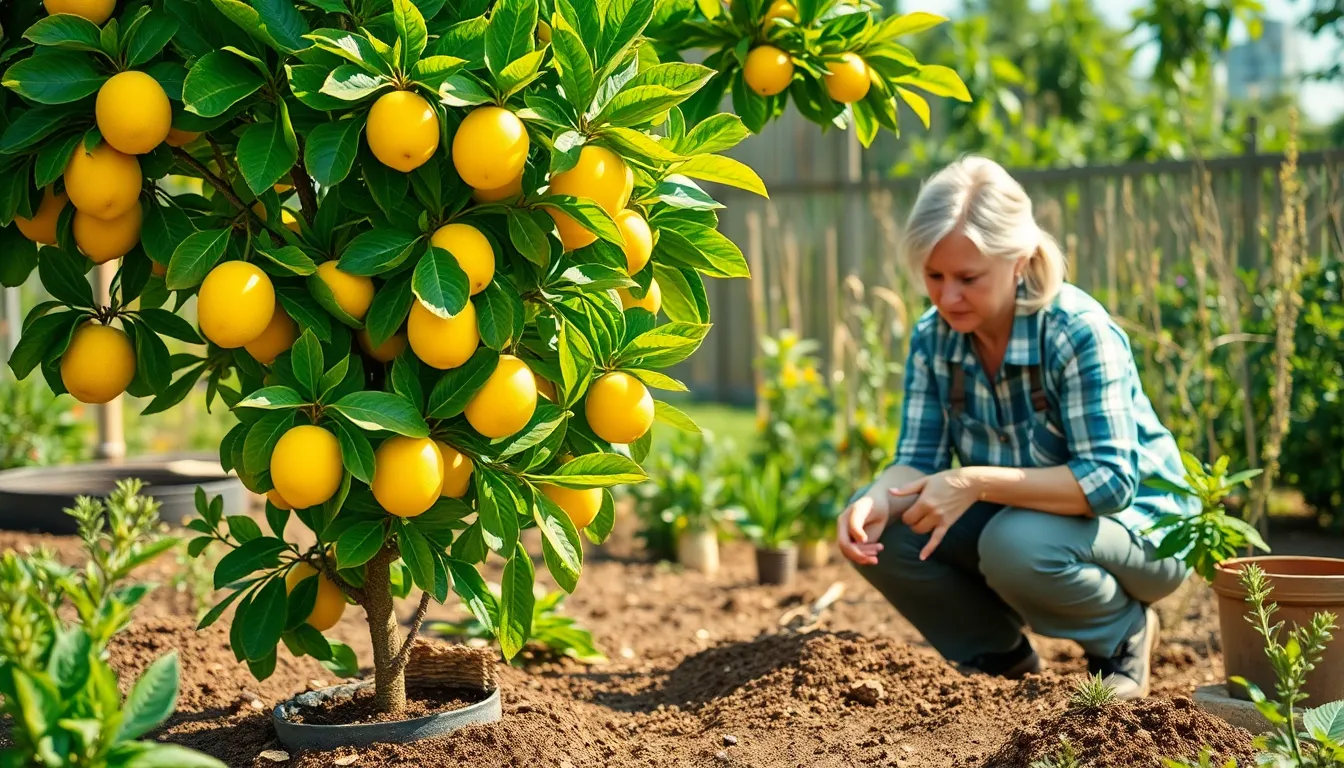
Proper fertilization forms the backbone of successful lemon tree cultivation. We need to understand the exact nutritional requirements of citrus trees to ensure our lemon trees produce abundant, flavorful fruit.
Essential Nutrients for Citrus Trees
Nitrogen, phosphorus, and potassium (NPK) serve as the primary building blocks for lemon tree growth and fruit production. Nitrogen promotes vigorous leaf growth and overall tree development, while phosphorus supports strong root systems and flowering. Potassium enhances fruit quality and helps trees resist disease and stress.
Micronutrients play equally important roles in maintaining tree health and preventing common deficiencies. Zinc deficiency often manifests as yellowing leaves with green veins, while iron deficiency causes new growth to appear pale or yellow. Magnesium supports chlorophyll production and helps maintain the deep green color of healthy lemon tree foliage.
Calcium strengthens cell walls and prevents fruit disorders like blossom end rot. Sulfur aids in chlorophyll formation and protein synthesis, while boron supports proper flower development and fruit set. These micronutrients work together to create the optimal conditions for lemon trees to thrive and produce high quality fruit.
Organic vs Synthetic Fertilizer Options
Organic fertilizers like compost and well-rotted manure provide slow-release nutrition while improving soil structure and beneficial microbial activity. These natural options include fish emulsion, bone meal, and specialized organic citrus fertilizers that feed both the tree and soil organisms. Organic matter breaks down gradually, reducing the risk of nutrient burn and creating long-term soil health benefits.
Synthetic fertilizers deliver quick results through readily available nutrients that trees can absorb immediately. Balanced NPK formulations like 10-10-10 or 20-20-20 provide precise nutrient ratios for rapid growth responses. Chemical fertilizers work well for addressing exact deficiencies quickly, though they may require more frequent applications.
Environmental considerations favor organic approaches for sustainable lemon tree cultivation. Synthetic options can contribute to nutrient runoff and soil degradation over time, while organic fertilizers build soil health and support beneficial insects and microorganisms. We recommend combining both approaches, using organic fertilizers as the foundation and synthetic options for targeted corrections.
Seasonal Feeding Schedule
Spring fertilization kickstarts new growth with balanced NPK fertilizers applied as temperatures warm and trees emerge from dormancy. We should begin feeding in early spring when new leaves appear, using a balanced 10-10-10 fertilizer or organic compost to support the burst of growth activity. This timing coincides with the tree’s natural growth cycle and prepares it for the growing season ahead.
Summer applications focus on increased nitrogen content to support vigorous leaf development and fruit formation during peak growing months. Monthly feeding during summer months helps maintain consistent growth, with emphasis on nitrogen-rich fertilizers or organic alternatives like fish emulsion. We need to monitor soil moisture during summer fertilization to prevent nutrient burn in hot weather.
Fall feeding shifts toward root development with reduced nitrogen and increased phosphorus to prepare trees for winter dormancy. This seasonal transition helps trees focus energy on establishing strong root systems rather than producing tender new growth vulnerable to frost damage. Potassium becomes particularly important during fall to enhance cold tolerance.
Winter maintenance requires minimal fertilization using low-nitrogen formulations to support tree health without stimulating growth during dormancy. Light applications of organic matter or specialized winter citrus fertilizers help maintain soil biology and provide gentle nutrition. We should avoid heavy fertilization during winter months when trees cannot effectively use excess nutrients.
Prune Your Lemon Tree for Health and Productivity
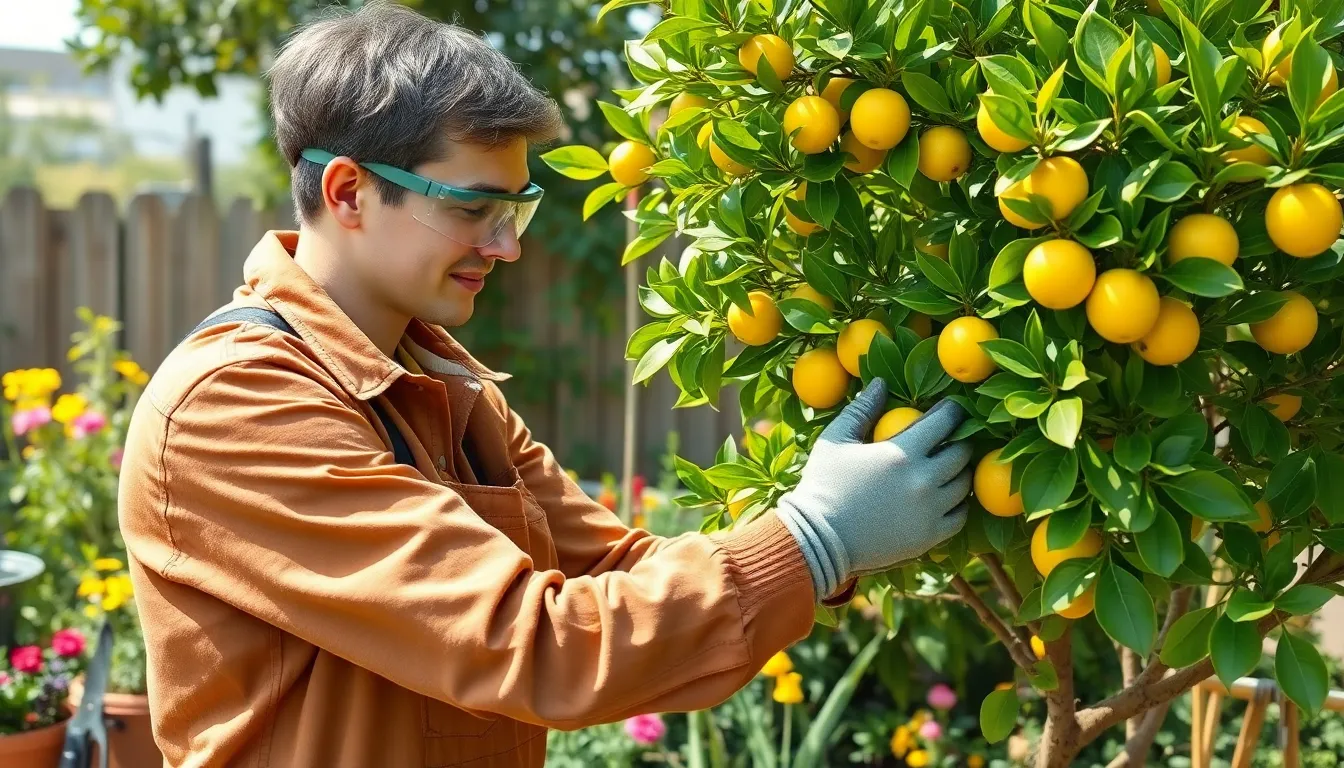
Proper pruning transforms your lemon tree into a more productive and healthier plant that’ll reward you with abundant harvests for years to come.
When to Prune for Best Results
Late winter or early spring provides the optimal pruning window for your lemon tree before its main growth period begins. We recommend scheduling this essential maintenance between February and March, when the tree remains dormant but before new buds start forming.
Avoid pruning during fall months since this timing can stress your tree and leave it vulnerable to frost damage during winter. Cold snaps present particular risks when fresh cuts haven’t had time to heal properly.
Spring pruning allows wounds to heal quickly as the tree enters its active growing season. Your lemon tree will channel energy into recovery and new growth rather than struggling through dormant winter months with open cuts.
Proper Pruning Tools and Techniques
Sharp, clean pruning shears or loppers ensure precise cuts that heal faster and reduce disease transmission risks. We always disinfect our tools with rubbing alcohol before and after each pruning session to prevent spreading pathogens between branches.
Clean cuts just above leaf nodes or branches promote healthy healing and encourage new growth in desired directions. Jagged or torn cuts from dull tools create entry points for pests and diseases that can compromise your tree’s health.
Sterilization between cuts becomes crucial when removing diseased or damaged wood to prevent contaminating healthy portions of your tree. Keep a cloth soaked in rubbing alcohol handy for quick tool cleaning during pruning sessions.
Shaping Young Trees vs Mature Trees
Young trees require framework establishment through strategic pruning that creates a strong, open structure for future growth. We focus on removing crossing or rubbing branches that compete for space and nutrients.
Central leader trimming encourages lateral growth in young lemon trees, creating the bushy shape that maximizes fruit production. Remove the main vertical shoot to redirect energy into side branches that’ll bear more lemons.
Mature trees need maintenance pruning that removes dead, diseased, or damaged wood while thinning crowded branches for better airflow and light penetration. These established trees benefit from selective branch removal rather than aggressive shaping.
Lower branch pruning maintains desired height and makes harvesting easier while preventing fruit from touching the ground where pests and diseases thrive. We typically remove branches that hang below 18 inches from the soil level.
Protect Your Lemon Tree From Pests and Diseases
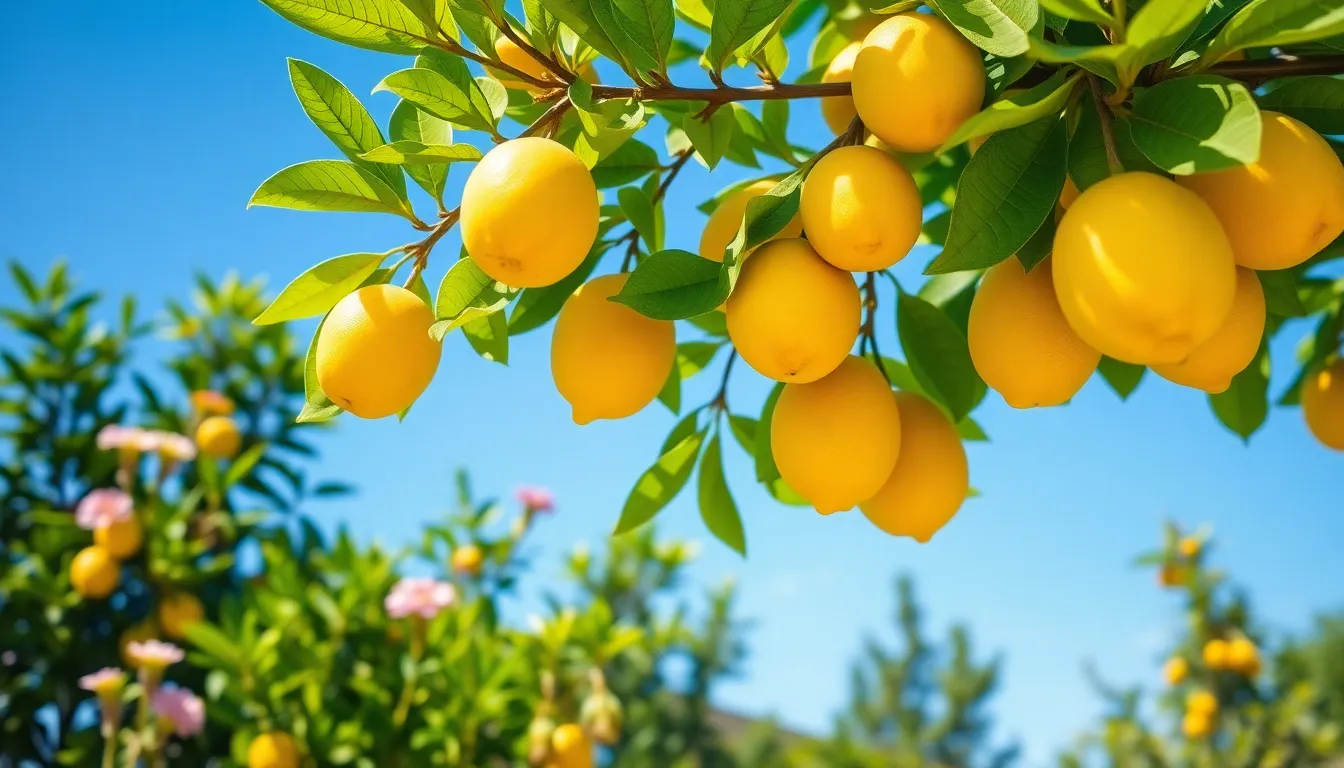
Regular protection against pests and diseases ensures your lemon tree remains healthy and productive throughout its growing season. Proactive management prevents small issues from becoming major problems that could damage your harvest.
Common Citrus Pests and Prevention
Aphids pose a important threat to lemon trees by clustering on new growth and leaves. These tiny insects suck plant juices and can cause yellowing, curling, or stunted growth. We recommend inspecting your tree weekly during growing season to catch infestations early.
Scale insects attach themselves to branches and leaves, appearing as small brown or white bumps. They weaken trees by feeding on plant sap and can lead to yellowing leaves and reduced fruit production. Regular monitoring helps identify these pests before they multiply.
Spider mites thrive in hot, dry conditions and create fine webbing on leaves. They cause stippling damage that appears as tiny yellow or white spots on leaf surfaces. Maintaining adequate humidity around your tree helps prevent spider mite infestations.
Prevention strategies include maintaining proper sanitation around your lemon tree by removing fallen leaves and debris. Keep weeds away from the base of your tree since they can harbor pests. Encourage beneficial insects like ladybugs and lacewings by planting companion flowers nearby.
Fungal Disease Management
Root rot develops when soil remains consistently waterlogged, causing roots to decay and turn brown or black. This serious condition can kill your lemon tree if not addressed quickly. Improving drainage through soil amendments prevents this common fungal disease.
Leaf spot diseases create circular brown or yellow spots on foliage that can spread rapidly in humid conditions. These fungal infections weaken your tree and reduce its ability to photosynthesize effectively. Proper air circulation around branches helps prevent leaf spot development.
Management techniques focus on cultural practices that reduce fungal growth. Remove affected plant parts immediately and dispose of them away from your garden. Avoid overhead watering that keeps leaves wet for extended periods.
Pruning infected areas stops disease spread and improves air circulation throughout the canopy. Make clean cuts with disinfected tools to prevent introducing new pathogens. Apply fungicide treatments only when natural methods prove insufficient.
Natural vs Chemical Treatment Options
Natural treatments offer safe, eco-friendly answers for pest and disease control on lemon trees. Neem oil serves as both an insecticide and fungicide, disrupting pest life cycles without harming beneficial insects. Insecticidal soaps effectively control soft-bodied pests like aphids and spider mites.
Horticultural oils smother scale insects and their eggs while being gentle on your tree and environment. Baking soda answers create an alkaline environment that inhibits fungal growth on leaves and branches. These homemade sprays cost less than commercial products and break down naturally.
Chemical treatments include systemic insecticides that move through plant tissues to control persistent infestations. Fungicides containing copper or sulfur provide stronger protection against serious fungal diseases. But, these products require careful application to avoid harming beneficial insects and pollinators.
Application timing matters regardless of treatment type you choose. Apply treatments during calm weather conditions to prevent drift onto nearby plants. Follow label instructions precisely and avoid treating during flowering periods to protect bees and other pollinators visiting your lemon tree.
Monitor Growth and Troubleshoot Common Problems
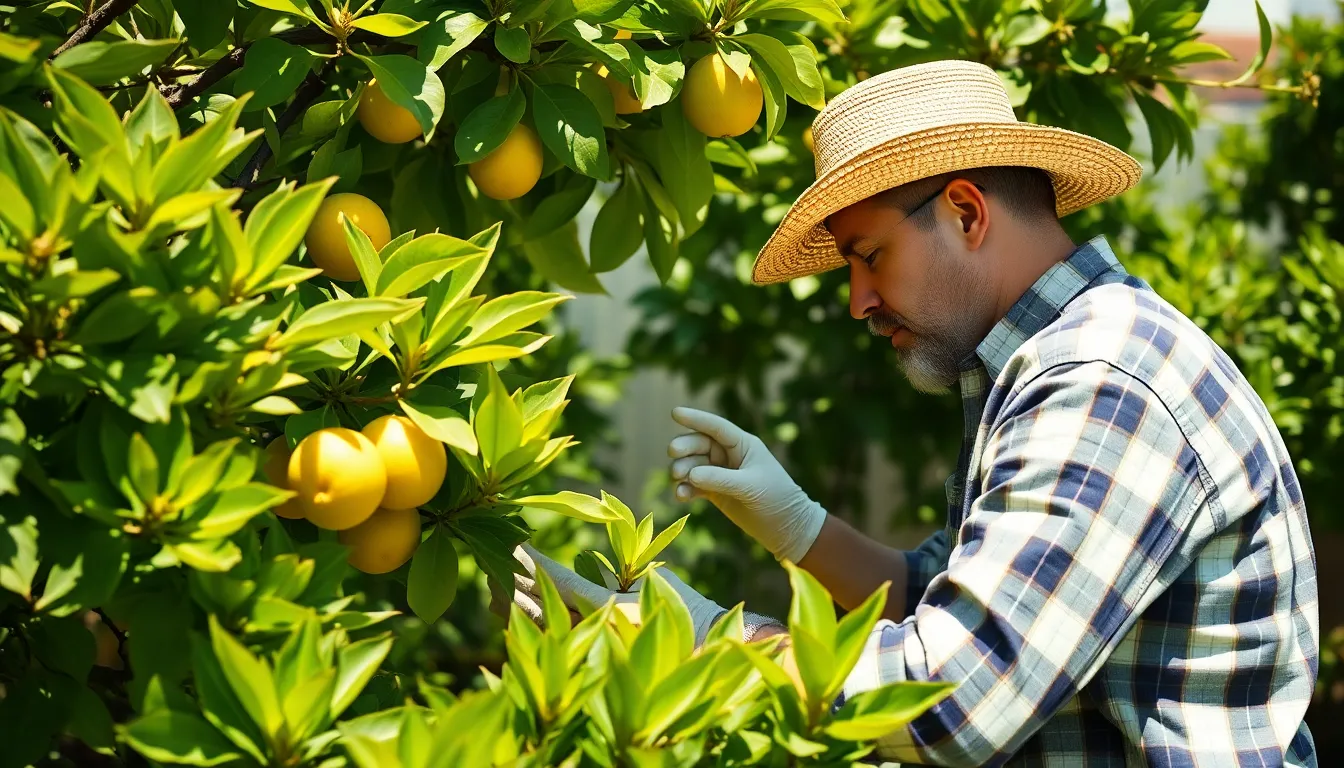
Regular monitoring helps us catch issues early and maintain healthy lemon tree growth. We’ll address the most common problems that can affect our trees’ productivity and overall health.
Yellowing Leaves and Nutrient Deficiencies
Yellowing leaves typically signal overwatering, nutrient deficiencies, or pest infestations affecting our lemon trees. Overwatering creates waterlogged conditions that prevent roots from absorbing oxygen properly, leading to leaf yellowing and potential root rot. We should check our watering schedule and ensure the soil drains well between waterings.
Nutrient deficiencies manifest through exact yellowing patterns on leaves. Nitrogen deficiency causes overall yellowing starting with older leaves, while iron deficiency creates yellowing between leaf veins with green veins remaining prominent. Magnesium deficiency shows as yellowing between veins on older leaves, and zinc deficiency causes small, yellowed leaves with shortened internodes.
Pest inspections help us identify aphids, scale insects, or spider mites that can stress trees and cause leaf discoloration. We should examine the undersides of leaves regularly and look for sticky honeydew or webbing that indicates pest presence. Regular fertilization with balanced citrus fertilizer addresses most nutrient deficiencies, while targeted treatments can correct exact mineral shortages.
Flower Drop and Fruit Production Issues
Flower drop occurs naturally but excessive dropping indicates stress, inadequate pollination, or nutrient imbalances in our lemon trees. Environmental stress from temperature fluctuations, irregular watering, or insufficient sunlight can cause flowers to drop before fruit sets. We need to maintain consistent care conditions with 6 to 8 hours of direct sunlight daily and steady moisture levels.
Pollination support becomes crucial for indoor trees or in areas with limited bee activity. We can hand pollinate flowers using a small brush to transfer pollen between flowers, increasing fruit set success rates. Outdoor trees benefit from attracting pollinators by planting nearby flowering plants that bloom during citrus flowering season.
Balanced fertilization prevents both flower drop and poor fruit development. Excessive nitrogen promotes leaf growth at the expense of flowering, while phosphorus deficiency reduces flower formation. We should use fertilizers with appropriate NPK ratios for citrus trees and supplement with micronutrients like boron, which directly affects flower and fruit development.
Cold Damage Prevention and Recovery
Cold protection prevents frost damage that can kill young growth and damage mature lemon trees in our gardens. Frost protection requires covering trees with frost cloths, blankets, or moving container plants indoors when temperatures drop below 32°F. We should monitor weather forecasts and prepare protection materials before cold snaps arrive.
Recovery techniques help damaged trees regain health after cold exposure. Pruning damaged areas back to healthy wood prevents disease and encourages new growth, but we should wait until after the last frost to avoid exposing fresh cuts to additional cold damage. Damaged bark and blackened leaves indicate the extent of cold injury that needs removal.
Extra care during recovery includes reduced watering since damaged roots can’t absorb water efficiently, and avoiding fertilization until new growth appears. We should provide consistent moisture without overwatering and protect recovering trees from additional stressors like pests or diseases that target weakened plants. Recovery can take several months, so patience and consistent care help our lemon trees bounce back stronger.
Harvest Your Lemons at Peak Ripeness
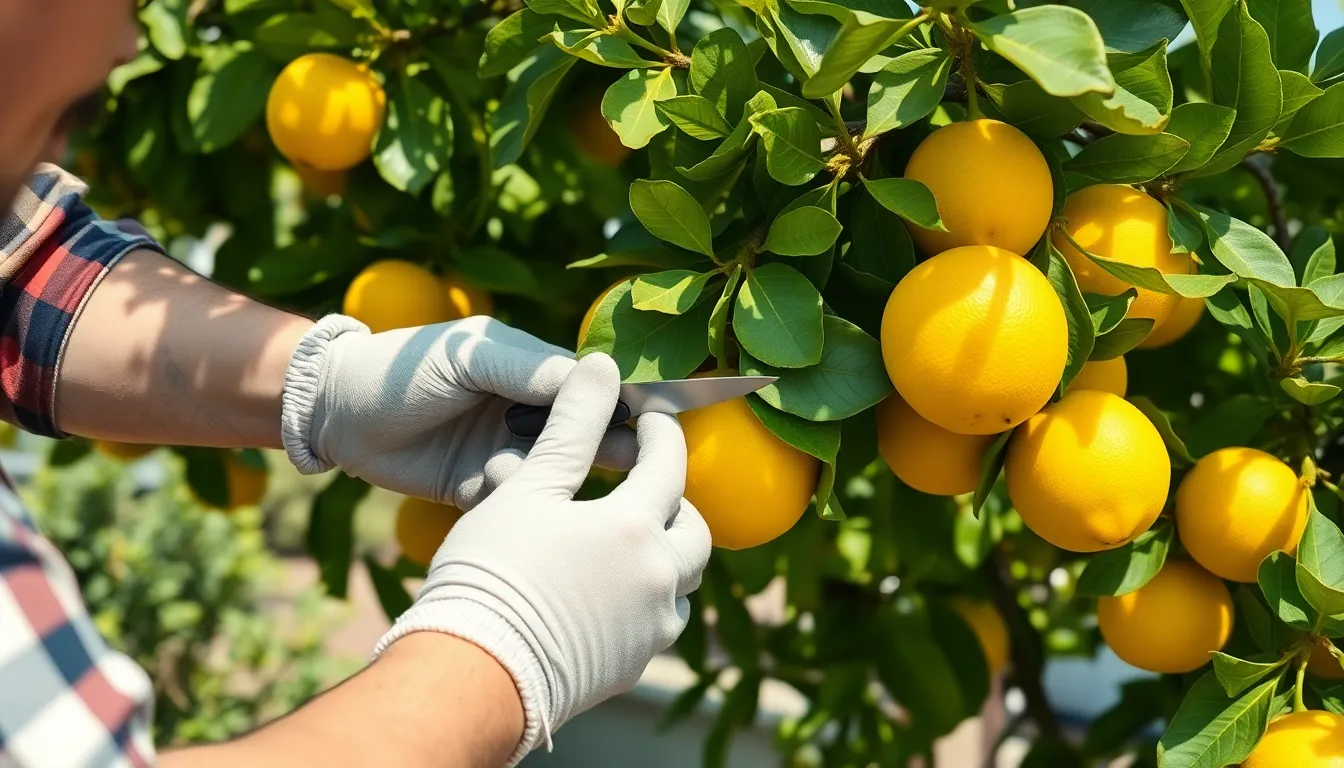
After months of careful cultivation, your lemon tree’s finally ready to reward you with fresh, juicy fruit. Knowing exactly when and how to harvest ensures you’ll get the best flavor and longest storage life from your homegrown lemons.
Signs of Lemon Maturity
Identifying ripe lemons requires attention to both visual and tactile cues that develop over several weeks. Color transformation serves as the primary indicator — ripe lemons display bright yellow skin with a slightly glossy appearance, while green lemons remain unripe and should stay on the tree longer.
Size consistency also signals maturity, as fully developed lemons reach their variety’s typical dimensions before changing color. We recommend gently squeezing the fruit to test firmness; ripe lemons feel solid and heavy for their size without any soft spots or wrinkled skin.
Skin texture provides another reliable maturity marker — mature lemons develop smooth, slightly waxy skin that reflects light, contrasting with the dull, rough texture of unripe fruit.
Proper Harvesting Techniques
Clean cutting tools prevent disease transmission and ensure healthy harvests throughout the season. We always use sharp scissors or garden shears that we’ve disinfected with rubbing alcohol before each harvesting session.
Stem cutting technique preserves both the fruit and tree health — cut the stem just above the fruit, leaving a small piece attached to the lemon rather than pulling or twisting the fruit off the branch. This method prevents bark damage and reduces stress on the tree.
Gentle handling maintains fruit quality during harvest and prevents bruising that can lead to premature spoilage. We hold each lemon carefully while cutting and place harvested fruit in padded containers rather than dropping them into collection bags.
Storage and Preservation Methods
Room temperature storage works best for lemons you’ll use within a week, keeping them on counters away from direct sunlight. Fresh lemons maintain optimal flavor and juice content when stored at temperatures between 65°F and 70°F.
Refrigerated storage extends shelf life for several weeks when you place lemons in the crisper drawer or produce bags. Cold temperatures slow down ripening and prevent moisture loss that leads to shriveling.
Freezing preservation offers long-term storage answers through multiple methods — juice lemons and freeze the liquid in ice cube trays for convenient portioning, or slice whole lemons and dehydrate them for zest and seasoning applications.
| Storage Method | Duration | Temperature | Best Uses |
|---|---|---|---|
| Room temperature | Up to 1 week | 65°F-70°F | Immediate cooking and juicing |
| Refrigerated | Several weeks | 35°F-40°F | Extended fresh use |
| Frozen juice | 6-8 months | 0°F | Beverages and recipes |
| Dehydrated slices | 12 months | Room temp | Seasoning and tea |
Conclusion
Growing your own lemon tree transforms from a simple gardening project into a rewarding journey that connects us with nature’s abundance. We’ve equipped you with everything needed to succeed—from selecting the perfect variety to mastering harvesting techniques.
The path ahead requires patience and consistency but the rewards are immeasurable. Fresh lemons year-round sustainable gardening practices and the satisfaction of nurturing life from soil to fruit make every effort worthwhile.
Your lemon tree will become more than just a plant—it’ll be a source of pride culinary inspiration and natural beauty in your space. With proper care and attention you’re well on your way to enjoying homegrown citrus for years to come.
Frequently Asked Questions
What is the best lemon tree variety for beginners?
Meyer lemons are ideal for beginners due to their compact size, sweet fruit, and forgiving nature. They’re easier to manage than other varieties and produce fragrant, thin-skinned lemons that are perfect for cooking and eating fresh. Meyer lemon trees also adapt well to container growing, making them suitable for various gardening situations.
How much sunlight do lemon trees need?
Lemon trees require 6 to 8 hours of direct sunlight daily for optimal growth and fruit production. Position your tree in a south-facing location to maximize sun exposure. Insufficient sunlight can lead to poor fruit development, weak growth, and increased susceptibility to diseases and pests.
What soil pH is best for lemon trees?
Lemon trees thrive in soil with a pH between 6.0 to 7.0, which is slightly acidic to neutral. This pH range ensures optimal nutrient absorption and prevents common deficiencies. Test your soil regularly and amend with organic matter or sulfur if needed to maintain the proper pH level.
When is the best time to plant a lemon tree?
Early spring, after the last frost has passed, is the ideal time to plant lemon trees. This timing allows the tree to establish its root system during the growing season before facing winter stress. Avoid planting during extreme weather conditions or when temperatures are consistently below 50°F.
How often should I water my lemon tree?
Water lemon trees deeply but infrequently to encourage deep root growth. During spring and summer, water 2-3 times per week, checking soil moisture 2-3 inches deep. Reduce watering frequency in fall and winter. Always ensure proper drainage to prevent root rot and adjust based on rainfall and temperature.
What nutrients do lemon trees need?
Lemon trees require balanced nutrition including nitrogen (N), phosphorus (P), and potassium (K), plus micronutrients like zinc, iron, magnesium, calcium, sulfur, and boron. Use citrus-specific fertilizers that provide these essential nutrients. Regular feeding during the growing season supports healthy growth and fruit production.
When should I prune my lemon tree?
Prune lemon trees in late winter or early spring, specifically between February and March, before new growth begins. This timing minimizes stress and allows the tree to heal quickly. Use clean, sharp tools and focus on removing dead, diseased, or crossing branches while maintaining the tree’s natural shape.
How do I know when lemons are ready to harvest?
Ripe lemons display bright yellow color, reach full size for their variety, and have smooth, firm texture. They should feel heavy for their size and give slightly when gently squeezed. Taste-test one lemon to ensure proper flavor development, as color alone doesn’t always indicate ripeness.
Can I grow a lemon tree indoors?
Yes, lemon trees can be grown indoors in containers, especially dwarf varieties like Meyer lemons. Ensure adequate sunlight (6-8 hours) or supplement with grow lights, maintain proper humidity, and provide good air circulation. Indoor trees may require hand-pollination to produce fruit and need regular fertilization.
How do I protect my lemon tree from pests?
Regularly inspect your lemon tree for common pests like aphids, scale insects, and spider mites. Maintain good garden hygiene, prune properly for air circulation, and use natural treatments like neem oil or insecticidal soap. Early detection and consistent monitoring are key to preventing serious infestations.
